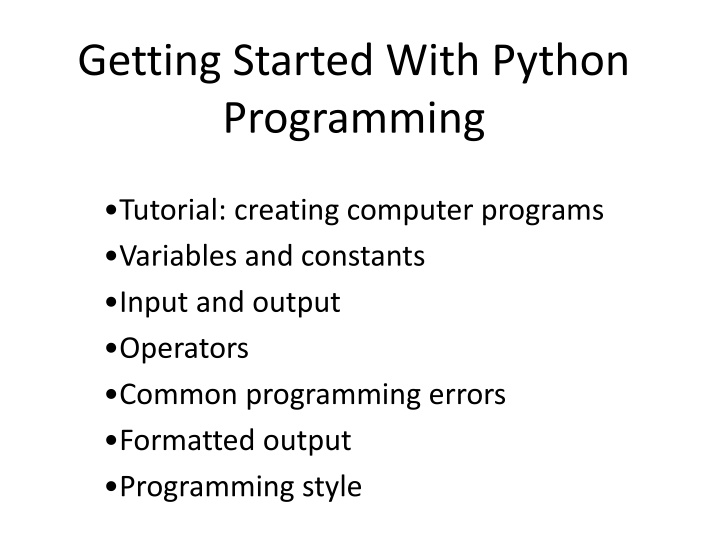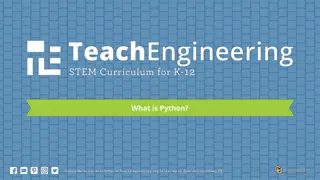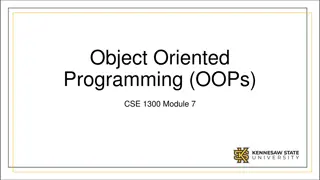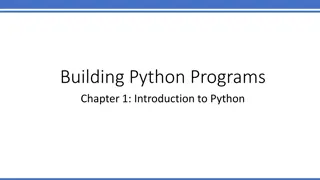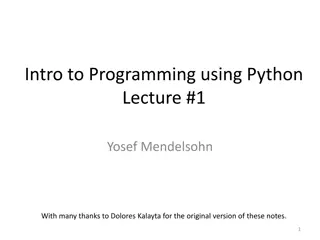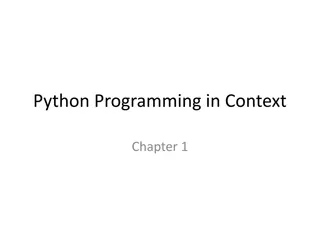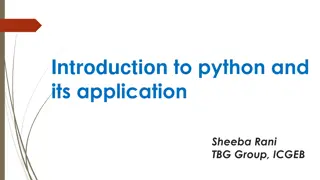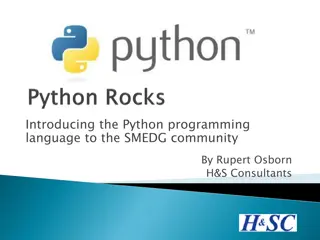Creating Computer Programs with Python Programming
"This tutorial covers variables, constants, input/output, operators, common errors, formatted output, and programming style in Python. Explore the advantages of Python, its history, and tips for success in programming. Master Python through extensive notes, programming practice, and understanding its concepts. Get started with Python programming now!"
Download Presentation

Please find below an Image/Link to download the presentation.
The content on the website is provided AS IS for your information and personal use only. It may not be sold, licensed, or shared on other websites without obtaining consent from the author.If you encounter any issues during the download, it is possible that the publisher has removed the file from their server.
You are allowed to download the files provided on this website for personal or commercial use, subject to the condition that they are used lawfully. All files are the property of their respective owners.
The content on the website is provided AS IS for your information and personal use only. It may not be sold, licensed, or shared on other websites without obtaining consent from the author.
E N D
Presentation Transcript
Getting Started With Python Programming Tutorial: creating computer programs Variables and constants Input and output Operators Common programming errors Formatted output Programming style
Reminder! These course notes are mandatory http://pages.cpsc.ucalgary.ca/~tamj/2018/231W/index.html#Course_to pics/notes,_assignment/exam_information Get them before class and go over them before attending (If all else fails then look through them afterwards at the very least to see what concepts/topics you are responsible for knowing). It s the *first* step you should complete if you ve missed lecture and need to catch up. (The second step is to get the in class notes of a classmate). After going through these notes the third step is to ask us for help in filling in any conceptual gaps. James Tam
Tips For Success: Programming Sections (The previous 4 tips are still applicable but there s some tips specific to programming): Take extensive notes: everything in class not just what the instructor writes down but also what he/she says in class . Some students may find when studying the lecture slides for the exam that they cannot understand concepts. The extra filling of the blanks occurs during lecture so you need to annotate the slides with your own notes After lectures have covered a particular concept/example If you have time try writing the program on your own (without looking at the online examples or notes) in order to create a program that fulfills the same task as the example program (It s one thing to see the solution to a problem explained, your depth of understanding will be deeper if you have to re-create it from scratch yourself). JT s note: you may find this unnecessary for the simple examples in this section but it will be beneficial to do this when more complex concepts are covered (e.g. nested loops onwards) James Tam
Python This is the name of the programming language that will be used to illustrate different programming concepts this semester: My examples will be written in Python Your assignments will be written in Python Some advantages (from Python dot org) Free Powerful Widely used (Google, NASA, Yahoo, Electronic Arts, some Linux operating system scripts etc.) Named after a British comedy Monty Python s Flying Circus Official website (Python the programming language, not the Monty Python comedy troop): http://www.python.org An overview of the web site: https://www.python.org/about/gettingstarted/ James Tam
Python History Developed in the early 1990s by Guido van Rossum. Python was designed with a tradeoff in mind(from Python for everyone (Horstman and Necaise): Pro: Python programmers could quickly write programs (and not be burdened with an overly difficult language) Con: Python programs weren t optimized to run as efficiently as programs written in some other languages. From: http://www.python.org/~guido/ James Tam
Working From Home Remotely login to the Computer Science network Advantage: The interface will be the same in the CPSC lab vs. working at home. If you login to the correct machine then your program is guaranteed to work in the lab (pick a Linux based machine). No need to transfer files because you are directly editing them on your CPSC account when you are at home Drawback: There is a fair learning curve at first Example: Connect using a remote login program such as SSH or Putty Info: http://pages.cpsc.ucalgary.ca/~tamj/resources/new_CPSC_student/w orking_at_home.html Downloads: Working from home, use Putty: http://www.ucalgary.ca/cpsc/files/cpsc/putty.zip Transferring files to/from home, use Filezilla: https://filezilla-project.org/ (The remote login software SSH comes with MacOS so no download is needed). Sometime later in the semester, in tutorial, the Teaching Assistants will show you how to use these programs. James Tam
Working From Home (Installing Python) Alternative (OK for 217/231 but not recommended for 219/233): Getting Python (get version 3.X and not version 2.X) http://www.python.org/download/ James Tam
Online Help: Official Python Site Basic explanation of concepts (for beginners: along with examples to illustrate) http://docs.python.org/py3k/tutorial/index.html (You may want to skip Step #1 and proceed immediately onto Step 2.1 and continue onto Step #3) James Tam
The Process Of Creating A Computer Program Typical programmer Translation A special computer program (translator) translates the program written by the programmer into the only form that the computer can understand (machine language/binary) Program Creation A person (programmer) writes a computer program (series of instructions). Execution The program is written and saved using a text editor. The machine/binary language instructions can now be directly executed by the computer. The instructions in the programming language (e.g., Python) are high level (look much like a human language). # Details in 2nd year 10000001 10010100 10000100 10000001 01010100 # Details later this term list = [1,2, a ] for element in list print(element) slide 9 (Images curtesy of James Tam) James Tam
Types Of Translators 1) Interpreters (e.g., Python is an interpreted language) Each time the program is run the interpreter translates the program (translating a part at a time). If there are any translation errors during the process of interpreting the program, the program will stop execution right when the error is encountered. Specify advantages: partial execution, multi-platform 2) Compilers (e.g., C , C++ are compiled languages) Before the program is run the compiler translates the program all at once. Has to be perfect before you get anything to run If there are any translation errors during the compilation process, no machine language executable will be produced (nothing to execute) If there are no translation errors during compilation then a machine language program is created which can then be executed . Advantage: faster, translate once James Tam
Location Of My Online Examples Finding them via the WWW: URL: http://pages.cpsc.ucalgary.ca/~tamj/2018/231W/examples Finding them in UNIX when you are logged onto a computer in the lab (or remotely logged in using Putty) Directory: /home/231/examples The locations of the example programs that are specific to this section of notes (each section will have be located in a sub- directory/sub-link): http://pages.cpsc.ucalgary.ca/~tamj/2018/231W/examples/intro /home/231/examples/intro FYI: examples I give TA s for tutorials will be in a different location: http://pages.cpsc.ucalgary.ca/~tamj/2018/231W/tutorialSchedule.html /home/231/tutorials James Tam
The First Python Program Program name: small.py Filename: 1small.py print ("hello",end="") James Tam
Creating/Running Programs: One Operating System The process is similar on other platforms/OS s (the TA s will show you how to do it on the lab computers (Linux) during tutorials). Step 1: Writing your program You need a text editor (e.g., WordPad, Notepad, Notepad++) to enter the program. It can be done using any editor that you want, but don t use a word processor (e.g., MS-Word) and remember to save it as a text file ending with the suffix dot-py .py James Tam
Creating/Running Programs: One Operating System (2) Step 2: Translating and running your program You need to open a command line to translate/run your Python program. The name of the Python translator is Python To translate/run your program type python filename.py at the command line. The first example program would be executed by typing python small.py For a program whose filename is called output1.py you would type python output1.py . Running /translating the program Output of program (result of running the program) James Tam
Important Reminders Make sure you type the whole file name (including the part after the period) when you translate/run your program. E.g., python small.py Unless you are very familiar with your operating system when you translate/run a program you should first navigate to the directory/folder where your Python program resides. JT: the cd command changes your directory (Windows and UNIX although something different is needed when changing Windows drives) Suppose my program was under: C:\231 (Windows) OR /home/231 (UNIX) To reach this location you could (shortcuts excluded for now) then type: c:\231 (Windows) OR cd /home/231 (UNIX) James Tam
Section Summary: Writing A Small Hello World Program You should know exactly what is required to create/run a simple, executable Python program. While you may not be able to create a new program from scratch at this point, you should be able to enter/run small.py yourself. James Tam
Variables Set aside a location in memory. Used to store information (temporary). This location can store one piece of information. Putting another piece of information at an existing location overwrites previous information. At mostthe information will be accessible as long as the program runs i.e., it s temporary Some types of information which can be stored in variables include: integer (whole), floating point (fractional), strings (essentially any characters you can type and more) Format (creating): <name of variable> = <Information to be stored in the variable> Image curtesy of James Tam Examples (creating): Integer (e.g., num1 = 10) Floating point (e.g., num2 = 10.0) Strings: alpha, numeric, other characters enclosed in quotes. e.g., name = "james" To be safe get in the habit of using double (and not single) quotes James Tam slide 17
The Assignment Operator: = The assignment operator '=' used in writing computer programs does not have the same meaning as mathematics. Don t mix them up! Example: y =3 (what is stored in x at this point) x =y (what is stored in x , y at this point) y =6 (what is stored in x , y at this point) What is the end result? How was this derived (what are the intermediate results from each assignment/line above)? See the program 2assignment.py James Tam
Variable Naming Conventions Python requirements: Rules built into the Python language for writing a program. Somewhat analogous to the grammar of a human language. If the rules are violated then the typical outcome is the program cannot be translated (nor run). A language such as Python may allow for a partial execution (it runs until the error is encountered). Style requirements: Approaches for producing a well written program. (The real life analogy is that something written in a human language may follow the grammar but still be poorly written). If style requirements are not followed then the program can still be translated but there may be other problems (more on this during the term). James Tam
Variable Naming Conventions (2) Examples #1: age (yes) 1. Style requirement: The name should be meaningful. 2. Style and Python requirement: Names must start with a letter (Python requirement) and should not begin with an underscore (style requirement). 3. Style requirement: Names are case sensitive but avoid distinguishing variable names only by case. x, y (no) #2 height (yes) 2x, _height (no) #3 Name, name, nAme (no to this trio) James Tam
Variable Naming Conventions (2) Examples #4: age, height, weight Age, HEIGHT 4. Style requirement: Variable names should generally be all lower case (see next point for the exception). 5. Style requirement: For names composed of multiple words separate each word by capitalizing the first letter of each word (save for the first word) or by using an underscore. (Either approach is acceptable but don t mix and match.) 6. Python requirement: Can't be a keyword (see next slide). (yes) (no) #5 firstName, last_name (yes to either approach) James Tam
Key Words In Python1 and as assert break class continue def del elif else except exec finally for from global if import in is lambda not or pass print raise return try while with yield 1 From Starting out with Python by Tony Gaddis James Tam
Variable Naming Conventions: Bottom Line Both Python and style requirements should be followed when creating your variables. James Tam
Extra Practice Come up with example names that violate and conform to the naming conventions. (You will have to go through this process as you write your programs anyhow so it s a good idea to take about 5 10 minutes to make sure that you know the requirements). James Tam
Section Summary: Variables What is a variable What are some types of variables available in Python How to create a variable in Python What are naming conventions for variables James Tam
Displaying Output Using The Print()Function This function takes zero or more arguments (inputs) Multiple arguments are separated with commas print() will display all the arguments followed by a blank line (move the cursor down a line). end=""isn t mandatory but can be useful to prevent Python from adding the extra line (when precise formatting is needed) Zero arguments just displays a blank line Simple Examples (3output1.py) print("hi") print("hey",end="") print("-sup?") James Tam
Print(" ") Vs. Print(<name>) Enclosing the value in brackets with quotes means the value in between the quotes will be literally displayed onscreen. Excluding the quotes will display the contents of a memory location. Example: 4output2.py aString = "Some message" print(aString) print("aString") James Tam
Print(" ") Vs. Print(<name>): 2 Format: print(arg1,arg2 )1 Example: 5output3.py num = 10.0 name = "james" print("Sup?") print("num=", end="") print(num) print() print("My name: ", name) Exercise 1: remove these quotes and see if you can correctly predict the results. Exercise 2: remove parts: 1) end= 2) print() and see if you can correctly predict the results. 1 From what you ve learned thus far each argument can be a constant string or name of a variable. James Tam
Triple Quoted Output Used to format text output (free form and to reduce the number of calls to the print() function) The way in which the text is typed into the program is exactly the way in which the text will appear onscreen. Program name: 6formatting1.py From Python Programming (2nd Edition) by Michael Dawson From a CPSC 231 assignment courtesy of James Tam James Tam
By Default Output Is Unformatted Example: num = 1/3 print("num=",num) The number of places of precision is determined by the language not the programmer Sometimes you get extra spaces (or blank lines) There may be other issues e.g., you want to display output in columns of fixed width, or right/left aligned output There may be times that specific precision is needed in the displaying of floating point values James Tam
Formatting Output Output can be formatted in Python through the use of format specifiers and escape codes James Tam
Format Specifiers (If There Is Time) Format: print ("%<type of info to display/code>" %<source of the info to display>) Doesn t literally display this: Placeholder (for information to be displayed) Example (starting with simple cases): Program name:7formatting2.py num = 123 st = "cpsc 231" print("num=%d" %num) print("course: %s" %st) num = 12.5 print("%f%d" %(num,num)) James Tam
Types Of Information That Can Be Formatted Via Format Specifiers (Placeholder) (If There Is Time) Specifier Type of Information to display %s String %d Integer (d = decimal / base 10) %f Floating point James Tam
Formatting Effects Using Format Specifiers (If There Is Time) Format: %<width>1.<precision>2<type of information> Examples (format specifiers to format output): Program name:8formatting3.p num = 12.55 print ("%4.1f" %num) print ("%5.1f" %num) print ("%3.1f" %num) print ("%3s%-3s" %("ab", "ab")) print ("%-3s%3s" %("ab", "ab")) 1 A positive integer will add leading spaces (right align), negatives will add trailing spaces (left align). Excluding a value will set the field width to a value large enough to display the output 2 For floating point data only. James Tam
One Application Of Format Specifiers (If There Is Time) It can be used to align columns of text. Example (movie credits, tabular or financial information) James Tam
Section Summary: Formatting Output (If There Is Time) How to use format specifiers (field width, precision) to format output James Tam
Escape Codes/Characters The back-slash character enclosed within quotes won t be displayed but instead indicates that a formatting (escape) code will follow the slash: Escape sequence Description Alarm: Causes the program to beep. \a Newline: Moves the cursor to beginning of the next line. Tab: Moves the cursor forward one tab stop. \n \t Single quote: Prints a single quote. \' Double quote: Prints a double quote. \" Backslash: Prints one backslash. \\ James Tam
Percent Sign1 (If There Is Time) If no format specifiers are used then simply enclose the % within the quotes of a print() statement print("12%") 12% If format specifiers are used within a call to print() then use one percent sign to act as an escape code for another percent sign to follow print("%f%%", %(100)) 100.000000% James Tam 1 Since the question inevitably comes up each term I m answering it here
Escape Codes (2) Program name: 9formatting4.py print ("\a*Beep!*") print ("hi\nthere") print ('it\'s') print ("he\\y \"you\"") James Tam
Escape Codes: Application It can be used to nicely format text output (alignment output, provide separators within and between lines) Program example: 10formatting5.py firstName = "James" lastName = "Tam" mobile = "123-4567" print("Last name:\t", lastName) print("First name:\t", firstName) print("Contact:\t", mobile) Escape codes for aligning text is even more valuable if the width of a field (data to be displayed) is variable e.g., comes from user input or a text file. James Tam
Section Summary: Escape Codes How to use escape codes to format output James Tam
Extra Practice Traces: Modify the examples (output using format specifiers and escape codes) so that they are still valid Python statements. Alternatively you can try finding some simple ones online or from a textbook. Hand trace the code (execute on paper) without running the program. Then run the program and compare the actual vs. expected result. Program writing: Write a program the will right-align text into 3 columns of data. Write a program the will left-align text into 3 columns of data. James Tam
Reminder: Variables By convention variable names are all lower case The exception is long (multi-word) names As the name implies their contents can change as a program runs e.g., income = 300000 income = income + interest Income = income + bonuses James Tam
Named Constants They are similar to variables: a memory location that s been given a name. Unlike variables their contents shouldn t change. This means changes should not occur because of style reasons rather than because Python prevents the change The naming conventions for choosing variable names generally apply to constants but the name of constants should be all UPPER CASE. (You can separate multiple words with an underscore). Example PI = 3.14 They are capitalized so the reader of the program can distinguish them from variables. For some programming languages the translator will enforce the unchanging nature of the constant. For languages such as Python it is up to the programmer to recognize a named constant and not to change it. James Tam
Why Use Named Constants 1. They make your program easier to read and understand # NO populationChange = (0.1758 0.1257) * currentPopulation Avoid unnamed constants whenever possible! Vs. #YES BIRTH_RATE = 17.58 MORTALITY_RATE = 0.1257 currentPopulation = 1000000 populationChange = (BIRTH_RATE - MORTALITY_RATE) * currentPopulation James Tam
Why Use Named Constants (2) 2) Makes the program easier to maintain If the constant is referred to several times throughout the program, changing the value of the constant once will change it throughout the program. Using named constants is regarded as good style when writing a computer program. James Tam
Purpose Of Named Constants (3) BIRTH_RATE = 0.998 MORTALITY_RATE = 0.1257 populationChange = 0 currentPopulation = 1000000 populationChange = (BIRTH_RATE - MORTALITY_RATE) * currentPopulation if (populationChange > 0): print("Increase") print("Birth rate:", BIRTH_RATE, " Mortality rate:", MORTALITY_RATE, " Population change:", populationChange) elif (populationChange < 0): print("Decrease") print("Birth rate:", BIRTH_RATE, " Mortality rate:", MORTALITY_RATE, "Population change:", populationChange) else: print("No change") print("Birth rate:", BIRTH_RATE, " Mortality rate:", MORTALITY_RATE, "Population change:", populationChange) James Tam
Purpose Of Named Constants (4) One change in the initialization of the constant changes every reference to that constant BIRTH_RATE = 0.998 MORTALITY_RATE = 0.1257 populationChange = 0 currentPopulation = 1000000 populationChange = (BIRTH_RATE - MORTALITY_RATE) * currentPopulation if (populationChange > 0): print("Increase") print("Birth rate:", BIRTH_RATE, " Mortality rate:", MORTALITY_RATE, " Population change:", populationChange) elif (populationChange < 0): print("Decrease") print("Birth rate:", BIRTH_RATE, " Mortality rate:", MORTALITY_RATE, "Population change:", populationChange) else: print("No change") print("Birth rate:", BIRTH_RATE, " Mortality rate:", MORTALITY_RATE, "Population change:", populationChange) James Tam
Purpose Of Named Constants (5) BIRTH_RATE = 0.1758 MORTALITY_RATE = 0.0001 populationChange = 0 currentPopulation = 1000000 populationChange = (BIRTH_RATE - MORTALITY_RATE) * currentPopulation if (populationChange > 0): print("Increase") print("Birth rate:", BIRTH_RATE, " Mortality rate:", MORTALITY_RATE, " Population change:", populationChange) elif (populationChange < 0): print("Decrease") print("Birth rate:", BIRTH_RATE, " Mortality rate:", MORTALITY_RATE, "Population change:", populationChange) else: print("No change") print("Birth rate:", BIRTH_RATE, " Mortality rate:", MORTALITY_RATE, "Population change:", populationChange) One change in the initialization of the constant changes every reference to that constant James Tam
When To Use A Named Constant? (Rule of thumb): If you can assign a descriptive, useful, self- explanatory name to a constant then you probably should. Example 1 (easy to provide self explanatory constant name) INCH_CM_RATIO = 2.54 height = height * INCH_CM_RATIO Example 2 (providing self explanatory names for the constants is difficult) calories used = (10 x weight) + (6.25 x height) - [(5 x age) - 161] James Tam
